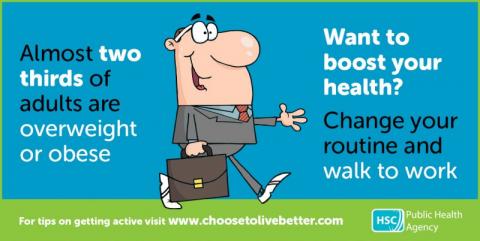Get moving with a work out at work

Too much time sitting can be bad for your health and many of us spend a lot of our work hours at a desk, so the Public Health Agency (PHA) is encouraging everyone to get up and get more active throughout the day.
Over three out of five of us are spending three or more hours in a sedentary position on weekdays, but with a few simple steps you can build moderate activity into your working day and reduce the amount of time sitting while still getting on with the job.
Colette Brolly, the PHA lead on Physical Activity, said: “It’s good to take a whole-day approach to being active as this will make it easier to hit the key goals for physical activity and reduce the amount of time you spend sitting. This includes thinking about the small things you can do, built around and into your work schedule.”
With 67% of men and 56% of women now overweight or obese, it is now more important than ever that we look at how we can adapt our behaviours to make healthier, more sustainable choices.
“Being more physically active and reaching the Chief Medical Officer’s recommended target of a minimum 150 minutes of moderate physical activity each week can help you manage your weight, reduce your risk of developing a range of chronic conditions including some cancers, and reduce anxiety and stress.
“150 minutes can sound daunting, but break it down in to smaller chunks. 30 minutes on at least five days is a good approach, and you can break that down further into 10-minute bouts of moderate activity that will fit in well with a busy working schedule. Basically, move more and sit less!”
Here are some ideas for getting up out of your seat:
- On the way to work, try walking or cycling for part or all of the journey. If you have to drive or take the bus, park the car a little further away from the office and walk the rest of the way. Hop off the bus a stop or two earlier and walk the rest of the way.
- When you get to work, try taking the stairs instead of the lift to get to the office.
- During the day, if you have to ask someone in the office something, walk to their desk rather than sending an email.
- At lunch, go for a walk rather than sitting at your desk. A 10 minute brisk walk adds to your recommended physical activity target of 30 minutes a day on at least five days per week.
- Standing up uses more muscles than sitting. You could stand each time you take a phone call.
- Stretch. Whether sitting or standing you can stretch at your desk to try to stop you feeling ‘stiff’ from sitting throughout the day.
- Walk and talk. If you have to talk to a colleague, try a walking meeting. It will keep you on your feet which will burn calories and be something different to talking around a table.
- Your organisation may already have some work-based physical activity programmes, so ask around and see if there are any to take part in and if not, offer to set one up and challenge your team or department to take part in initiatives such as 10,000 steps walking programme.
Moderate activity can include a brisk walk or riding a bike and don’t forget that any activity is better than none.
A range of helpful tips on getting active can be found on the Public Health Agency websites www.getalifegetactive.com and www.choosetolivebetter.com
Notes to editors:
- The recommended guidelines from the Chief Medical Officer on physical activity are that adults should aim to be active every day and achieve at least 150 minutes of moderate physical activity over a week. One way of achieving this is getting 30 minutes of activity at least five times per week.
- Over two-fifths (44%) of respondents to the Northern Ireland Health Survey 2013/14 aged 19 and over, reported having over four hours of sedentary time per day on weekdays. Respondents tended to have more sedentary time on weekends, with around half (54%) reporting over four hours of sedentary time per weekend day.
- A quarter of adults (24%) were obese with a further two-fifths (37%) classified as overweight. Males (67%) were more likely than females (56%) to be overweight or obese.
- 10,000 steps challenge – research has shown that walking 10,000 steps a day can improve your health. The 10,000 step challenge is all about encouraging work colleagues to compete to see who can reach the 10,000 step target each day using pedometers and keeping a leader board of participants. More info can be found on http://www.nhs.uk/Livewell/loseweight/Pages/10000stepschallenge.aspx
